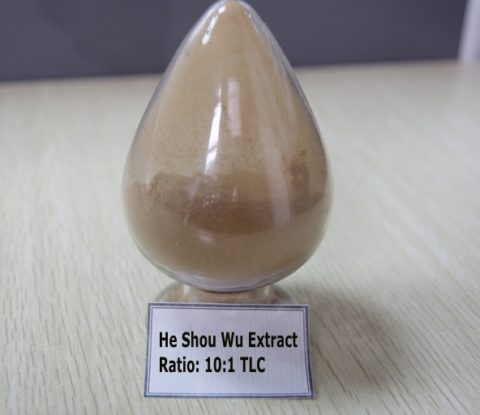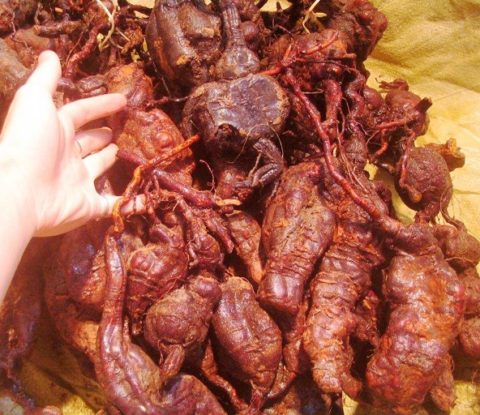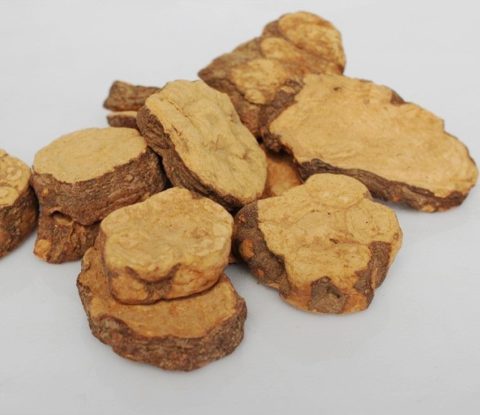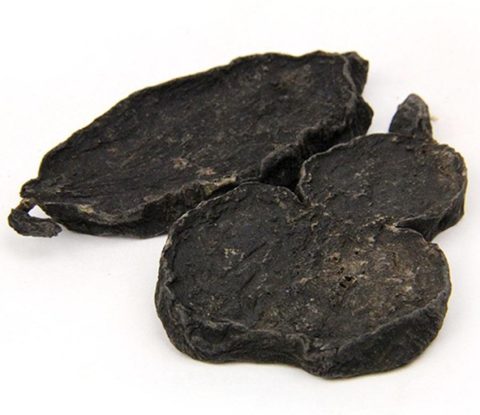
Prepared He Shou Wu Extract
【Product Name】: He shou wu, fo-ti,Tuber Fleeceflower Root, Radix Polygoni Multiflori, Fallopia multiflora.
【Latin Name】: Polygonum multiflorum Thunb
【Specification】: 10:1,20:1,50:1 TLC
【Appearance】: Brown fine powder
【Part Used】: Root
【Particle Size】: 100% through 80 mesh
【Function】: Enhance immunity
Introduction of He Shou Wu
This root is called Fo Ti in the American market, but its Chinese name is He Shou Wu. It is a Chinese rejuvenative herb famous for promoting healthy hair, skin and sexual vitality. He Shou Wu contains rich phospholipids. Phospholipids play an important role in maintaining the completion of the cell membrane structure and its functions. He Shou Wu has a number of applications in Traditional Chinese Medicine. The common use is as a tonic to promote longevity. The anti-aging effects of He Shou Wu are due to its ability to nourish the essence and increase the production of SOD, the enzyme most prominent for fighting free radicals that cause premature aging and cellular damage. The prepared He Shou Wu is uniquely different from its raw form in that the traditional preparation enhances the overall effectiveness and is the most easily assimilated.
He Shou Wu is one of the most popular and highly revered tonic herbs in Asian herbalism. It shares the position as the primary essence (Jing) tonic of Chinese herbalism with Lycium fruit (Goji berry). He Shou Wu is unsurpassed in its ability to provide deep, primordialenergy (Jing, essence) to the cells of the body via the kidney systems. He Shou Wu supplements the human body’s “functional reserve.” It is widely used in Chinese tonic herbalism as a tonic to prevent premature aging by tonifying the kidney and liver functions, toning up Jing (vital essence), nourishing the blood, and fortifying the muscles, tendons, and bones. It strengthens and stabilizes the lower back and knees. It is used to enhance sexual drive, increase sperm count, and strengthen sperm and ova. It is widely used in Asia to maintain the youthful condition and color of the hair. It will calm the nervous system. Because it has components that are potent antioxidants with gently anti-inflammatory action in the liver it can clear the eyes. Its strength comes from its remarkable ability to cleanse the body by cleaning the kidney and liver, which in turn clean the blood. By virtue of its ability to accumulate tremendous quantities of Qi (the traditional Chinese medicine concept for life energy, sometimes pronounced chi) into its root, this herb can tonify these organs and can fortify and nourish the blood. He Shou Wu is also very rich in iron. He Shou Wu is not a stimulant. He Shou Wu is extremely rich in potent antioxidants and in antioxidant-potentiating molecules. He Shou Wu stimulates the body’s innate ability to efficiently clear superoxide, the highly reactive free radical, from the body.
Active Constituents
The tuberous root of Polygonum multiflorum (He Shou Wu) has many active constituents. He Shou Wu is rich in anthraquinones, including many phospholipids such as lecithin (3.7%). A stilbene glycoside known as 2,3,5,4-tetrahydroxystilbene-2-O-β-D-glucopyranoside (henceforth refered to as “he shou wu super-glycoside”) is considered to be the principle active constituent responsible for He Shou Wu’s very powerful antioxidant activity. There are many similar stilbene glycosides present in He Shou Wu. The stilbene glycosides in He Shou Wu are very similar to resveratrol. Several of the stilbene glycosides in He Shou Wu are stronger antioxidants than resveratrol.
Difference betwen“Prepared” and“unprepared” He Shou Wu
In Chinese medicine the dried (unprepared) root and the prepared root are considered two different herbs. The unprepared root is used to relax the bowels and detoxify the blood. The prepared root is used to strengthen the blood, invigorate the liver and kidneys, and supplement vital energy (qi).
The freshly picked tubers tuber of He Shou Wu (Polygonum multiflorum) are sliced, stewed in black bean soup (in a proportion of 10 parts He Shou Wu to 1 part black beans) until the soup is exhausted. The “prepared” roots are then dried under the sun. This is the most regular “preparation” method for He Shou Wu in Traditional Chinese Medicine, and there is no chemicals are added in the making of “prepared” He Shou Wu.
A research was recently published, under the name “Changes in Chemical Components of Root of Polygonum Multiflorum Thunb and how Maillard Reaction involves during the Heating Process” (you can google it). The article argues that the best He Shou Wu root is the one that has been stewed in the black bean sauce for 32 hours. The heat processing indeed destroys some compounds (e.g., emodin is decreased), but it also triggers chemical reactions that create new compounds not found in the raw version of the root. Some data suggests that those chemical reactions makes the prepared He Shou Wu possess anti-oxidant, chemopreventative, anti-mutagenic etc activity.
Why Prepared He Shou Wu Is Much Milder and Safer than Unprepared He Shou Wu?
The conjugated anthraquinones (such as emodin) present in unprepared He Shou Wu are laxative. After preparation, the amount of conjugated anthraquinones in He Shou Wu decreases, while the free form anthraquinones that have many health-supporting and protective benefits significantly increase. This is why prepared He Shou Wu has a much milder or nil laxative effect compared to raw roots.
Efficacy and Function Difference: The “preparation” eliminates the laxative effect of He Shou Wu and brings out the tonic effect. In addition to toxicity elimination, the special preparation process also enhances He Shou Wu’s therapeutic efficacy. He Shou Wu is known to support macrophages. In a test where mice were fed He Shou Wu prepared by different methods, or not prepared at all, at the dose of 6g/kg, only the prepared He Shou Wu that was stewed and steamed with black soybean soup for 32 hours was shown to support the phagocytic activity of abdominal macrophage. He Shou Wu that was raw or prepared differently showed no obvious results.
Does the black beans soup being cooked with He Shou Wu leave the product having an estrogenic effect, if not why?
The amount of black soybeans in the final extract is very small. You would get more phytoestrogens in a handful of most nuts and many seeds. The proprietary ratio of he shou wu roots to black soybeans is about 10:1. The soybeans disintegrate to an extent during the steeping. The he shou wu roots are removed and then extracted. Each step continues to reduce the amount of black soybean content, however there was still enough to properly ‘prepare’ the he shou wu and make it far less stool softening and far more tonic than raw he shou wu.
Benefits of Prepared He Shou Wu
1).Prepared He Shou Wu extract increases the cellular antioxidant activity
He Shou Wu supports the body’s innate ability to efficiently clear superoxide, the highly reactive pro-oxidant (free radical), from the body. This is a normal function that occurs trillions of times a day in every human being.All organisms maintain complex innate antioxidant systems to prevent damage by oxidation. Antioxidants are chemicals that reduce the rate of oxidation reactions. Oxidation reactions are chemical reactions that involve the transfer of electrons from one substance to an oxidizing agent. Oxidation is a constant function of life that is accelerated by stress and many other factors. He Shou Wu is rich in potent antioxidants and in antioxidant-potentiating molecules.
2).Superoxide dismutase (SOD)
Superoxide dismutase (there are actually multiple forms of it) is a critical antioxidant enzyme that your body makes as a defense against superoxide. Superoxide is one of the most dangerous free radicals that can occur in your body and superoxide dismutase is your body’s solution to its presence. Superoxide when left to do its thing will damage any type of tissue, but most notably has the ability to damage our DNA. Superoxide dismutase is the king of antioxidants (even above resveratrol) since it can prevent the damage to our DNA which is the fundamental cause of all aging.
Superoxide dismutase levels decrease with age and this allows more opportunities for cells to incur genetic defects. These defects are then spread throughout the body as cells divide, eventually leading to all forms of disease. Fo-Ti root has been shown to increase the body’s production of superoxide dismutase. One controlled study compared blood SOD (superoxide dismutase) levels of mice at 11 months old. The group that had been fed a He Shou Wu extract for 7 months had SOD levels in their blood equivalent to that of 2 month old mice not on the extract. The control group of mice showed a strong decline in SOD production after the 11 month period.
He Shou Wu has been shown to help maintain youthful levels of SOD in laboratory animals even as they age. It is widely believed that the SOD generating capacity of He Shou Wu is one of the reasons it has been found to have anti-aging and longevity increasing activity. Studies have also demonstrated that various laboratory animals fed He Shou Wu in their diets lived longer than control animals:
Study 1: A decoction with He Shou Wu as the main ingredient prolonged the lifespan of fruit flies. At 0.1% strength, the decoction could prolong the lifespan by 5.83%. At 0.5% strength, it could prolong the lifespan by 12.03%.
Study 2: He Shou Wu has been shown to slow down the aging of vital organs in aged animals, especially the reproductive organs, the ovary, the uterus and the testicle. The same formula also demonstrated significant results in open human clinical studies.
Study 3: In an attempt to prove Shou Wu’s legendary reputation as being able to reverse gray hair to black, Shou Wu liquor (dilute alcohol extract) was given to 36 people with gray hair. 24 completely recovered their dark hair and 8 more showed improvement. The total effective rate was of 88.9%.
3).Protects the Liver
In experiments on mice, prepared He Shou Wu reduces buildup of hepatic (liver) fat. He Shou Wu also lessens the enlargement of the liver caused by carbon tetrachloride poisoning. He Shou Wu can significantly counter the liver damage in rats caused by peroxidized (spoiled) corn oil. The damage includes fatty liver, liver function damage and elevated levels of peroxidized lipids in the liver.
At a fundamental level in the liver’s cells, in vitro studies have demonstrated He Shou Wu`s ability to inhibit the lipid peroxidation of rat liver microsomes induced by ADP and NADPH. These studies show that He Shou Wu’s liver protection mechanism relies largely in its ability to inhibit lipid peroxidation (LPO) and its damage to the liver cells.
4). A zinc supplement
The zinc content of prepared He Shou Wu is as high as 42 mg per 100 grams the herb. This is several dozen times higher than that of most herbs. Animal type foods are considered to be high in zinc, but they only have 3-5 mg per 100 gram, much lower than the 42 mg in He Shou Wu. Zinc is an essential trace mineral required by all forms of life. Numerous aspects of cellular metabolism are zinc-dependent. Zinc plays important roles in growth and development, the immune response, neurological function, and reproduction. On the cellular level, the function of zinc can be divided into three categories: (1) regulatory, (2) catalytic, and (3) structural. Zinc supports the metabolism of testosterone, and supports sperm quality and motility.
Indications in Traditional Chinese Medicine
1).Blood and essence deficiency syndrome
Being mild in property–neither dry nor greasy–and with the actions of tonifying blood and supplementing essence, it is a good tonic. For blood and essence deficiency, vertigo and tinitus, soreness and flaccidity of lumbar and knees, early white of beard and hairs, it is combined with other liver and kidney-nourishing herbs and blood and essence-tonifying herbs, for instance, it is used with Gou Qi Zi, Tu Si Zi and Dang Gui in Qi Bao Mei Ran Dan from Ji Shan Tang Jing Yan Fang (Experiential Prescriptions from Jishan Clinic).
2).Chronic malaria
It is very indicated for chronic malaria of both qi and blood deficiency type, because both raw and prepared He Shou Wu can check malaria. Furthermore, it can tonify blood to improve deficiency. For instance, it is used with Ren Shen and Dang Gui in He Ren Yin from Jing Yue Quan Shu.
3).Ulcers and tuberculosis
Raw Shou Wu is indicated for ulcers and tuberculosis, because it can relieve toxicity, dissipate nodulation, in addition, it also has action of relieving itching. For swelling and pain due to ulcers, it is usually combined with phlegm-eliminating herbs and heat-toxin-clearing herbs, for instance, it is used with Jin Yin Hua, Lian Qiao and Ku Shen in He Shou Wu Tang from Yang Yi Da Quan (A Complete Handbook on Traumato-Orthopedics). For tuberculosis, it is usually combined with phlegm-eliminating herbs, toxicity-relieving herbs and nodulation-dissipating herbs, for instance, it is used with Xia Ku Cao and Chuan Bei Mu from Ben Cao Hui Yan (Supplement Materia Medica). For swelling, itching and pain due to ulcers, it is usually combined with herbs to clear heat, dry dampness, disperse wind and relieve itching, for instance, it is used with Ku Shen, Fang Feng and Bo He in He Shou Wu San from Wai Ke Jin Yi (Essence Argument of External Medicine).
4).Consripation due to intestinal dryness
Sheng Shou Wu can smooth stool through moistening intestines, and tonifying deficiency. For constipation due to blood deficiency with intestinal dryness, it could be used singly or combined with blood-nourishing and stool-smoothing herbs, for instance, it is used with Huo Ma Ren and Dang Gui.








